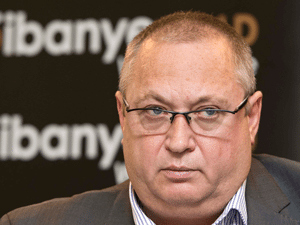
[miningmx.com] – Neal Froneman, the bull-necked, no-nonsense leader of Sibanye Gold, has attracted his fair share of criticism through the years, good and bad.
His credo is something akin to “don’t die wondering’, and he won’t. Deal-making in Aflease Gold, Uranium One and Gold One International, companies he previously managed, returned mixed results, hence the widely differing perspectives of Froneman’s career. Investing with him is, to resurrect the cliche, a roller-coaster ride.
So it’s no great surprise to see that in just over two years into the job at Sibanye – surely his biggest assignment yet – Froneman has been an active commentator, if not player, in the merger and acquisition (M&A) of South Africa’s precious metal assets.
In August, 2013, he issued 17% of Sibanye’s shares, equal to R1.2bn, for the Cooke 1 to 4 underground gold shafts on the West Rand, as well as a large parcel of gold dumps which contains gold now mineable given today’s technological advances in extraction.
A few months later, in December, he bought the distressed gold exploration company, Witwatersrand Gold for R400m whilst in November he’d already been involved in a minerals swap with neighbour, Harmony Gold.
Whilst not exactly modest in terms of M&A activity, Froneman is about to return to the dealmaking market with more gusto, especially as the deterioration in South Africa’s mining sector is so chronic that M&A is becoming a business necessity.
As the old saying goes, Sibanye is going to take someone home from the party, it’s just a matter of who.
The expectation is that one partner will be Harmony Gold, which at about R5bn is closing in on mid-cap status after being South Africa’s largest gold producer less than a decade ago.
Froneman has spoken of gold sector consolidation where the business motivation is corporate costs. Most of the mining costs have already been taken out by existing owners, he argues. Buying a company, however, removes the duplication in managerial staff, office costs and the like.
It’s also increasingly likely Sibanye will close a deal for the Rustenburg assets of Anglo American Platinum after acknowledging at his group’s interim results earlier this month that market conditions in the platinum group metals industry had made for more “realistic sellers’. For its part Amplats has suggested it won’t seek to bleed the last dollar for its assets.
On top of that, there’s a number of organic growth prospects including the so-called West Rand Tailings Retreatment Plant (WRTRP) which are the “dumps’ bought with the Cooke acquisition in 2013 mentioned previously.
According to Froneman, Sibanye will produce 1.2 million ounces of gold after mining a maximum of 30% of the resources at the dumps, as well as 35 million pounds of uranium oxide. Based on internal company assessments, the project will have a net asset value of up to R3.6bn in its first phase.
Froneman won’t, however, disclose the capital that’s required for the project. “I don’t want to create a capital overhang,’ he told analysts referring to the likelihood of company valuations being depressed by the debt or equity Sibanye required to fund the project.
That’s probably wise.
Scrutiny of mining company balance sheets is as acute as it’s ever been since metal prices have been falling so rapidly that miners can’t generate enough revenue to service existing debts. Share prices subsequently fall which makes issuing shares to stay liquid equally unfeasible.
FUNDING
Given that Sibanye Gold has committed itself to a R1bn full-year dividend target, it raises the question as to how Froneman is going to fund the company’s exertions. (Froneman acknowledged that a dividend of that quantum remained a target, albeit an increasingly difficult one to meet).
“We gave a capital hump in front of us,’ Froneman told analysts and media. “We will have to do some prioritising. Some projects may be slowed down for when we have more cash. We haven’t done the exercise yet, but acutely aware have to do it,’ he said.
In addition to a platinum deal, a possible gold sector megadeal, Froneman has also flagged his company’s interest in buying a coal mine in order to secure energy through an independent power producer.
This will require capital as will the ongoing feasibility study to further the Burnstone mine (from the Wits Gold deal), and the extensions of the firm’s existing Kloof and Driefontein mines (4 and 5 shafts).
In an interview with Miningmx earlier this month, however, Froneman spun out some likely financing scenarios, saying that he thought the balance sheet could support total net debt of more than R10bn versus the R1.7bn that sat on the balance sheet as of June 30.
Said Froneman: “We have enough headroom out of cash flow, assuming a certain gold price, but we won’t issue equity when we think it’s under-valued’. Shares in Sibanye Gold have fallen 21% in the last 30 days (as of August 7) and 44% over the last three months – a performance not out of kilter with its peer group.
One possible avenue is “semi-equity’, however, which is where debt is issued to investors and existing shareholders that eventually converts to Sibanye Gold shares at a certain term.
“Some stuff can also be financed off the balance sheet such as uranium off-take agreements,’ he added. In terms of this approach, buyers of uranium would fund today the future production from the WRTRP. “There’s a whole menu of options and I think we can take R10bn of debt in addition to what we’ve got now,’ he said.
Analysts think Sibanye has to deal in the M&A market come what may. Despite a recovery in Sibanye’s fortunes in the second quarter, Froneman was still fighting off perceptions that “the honeymoon was over’.
“We believe a transformational deal in the precious metals sector that secures well priced free cash flow growth remains critical to suspending the dividend,’ said Derryn Maade, an analyst for HSBC who added that M&A is preferable to any of the projects Sibanye has on its boards.
“Projects still look unenticing, in our view,’ said Maade. “The update to the WRTRP shows an IRR [internal rate of return] of 15% and payback of nine years which we find unattractive in the current industry climate,’ he added.
At heart of Froneman’s expansion exertions is the necessity to keep generating cash in increasingly difficult market conditions.
For the first half of the year, the company was cash flow negative. It still paid a dividend of 10 cents/share, equal to a yield of about 1.2%, but it’s not the bumper payouts upon which Sibanye’s business case was first predicated, hence the claims the “honeymoon is over’.
Said James Oberholzer, an analyst for Macquarie First South: “While the reduction is considered prudent given the fact that Sibanye was cash flow (after capex) negative during 1Q15 and 1H15 as well as the prevailing US$ gold price weakness and potential risk of strike action through the ongoing South African wage negotiations, this will perhaps disappoint some investors who are attracted to the name for promising yields’.











